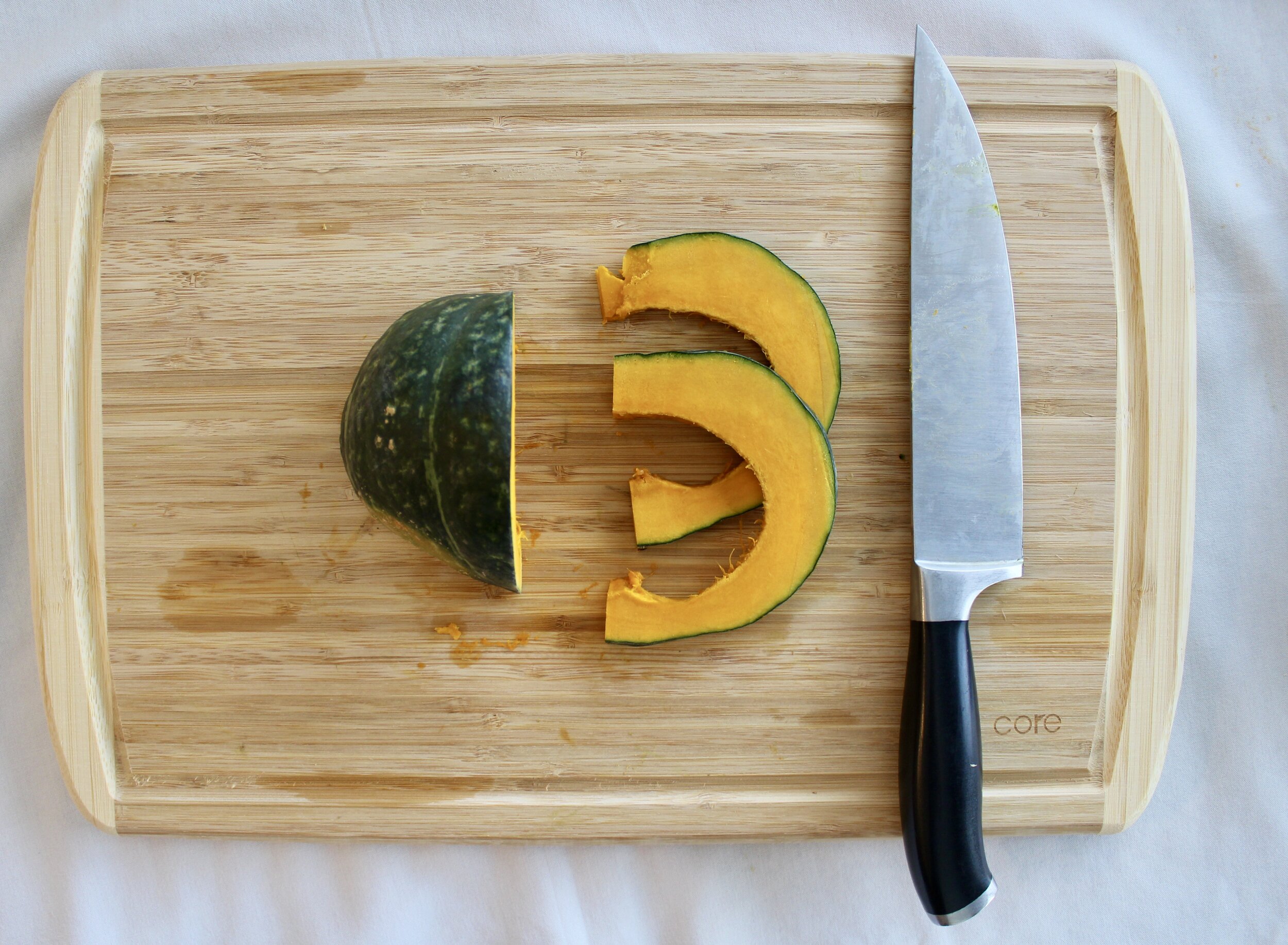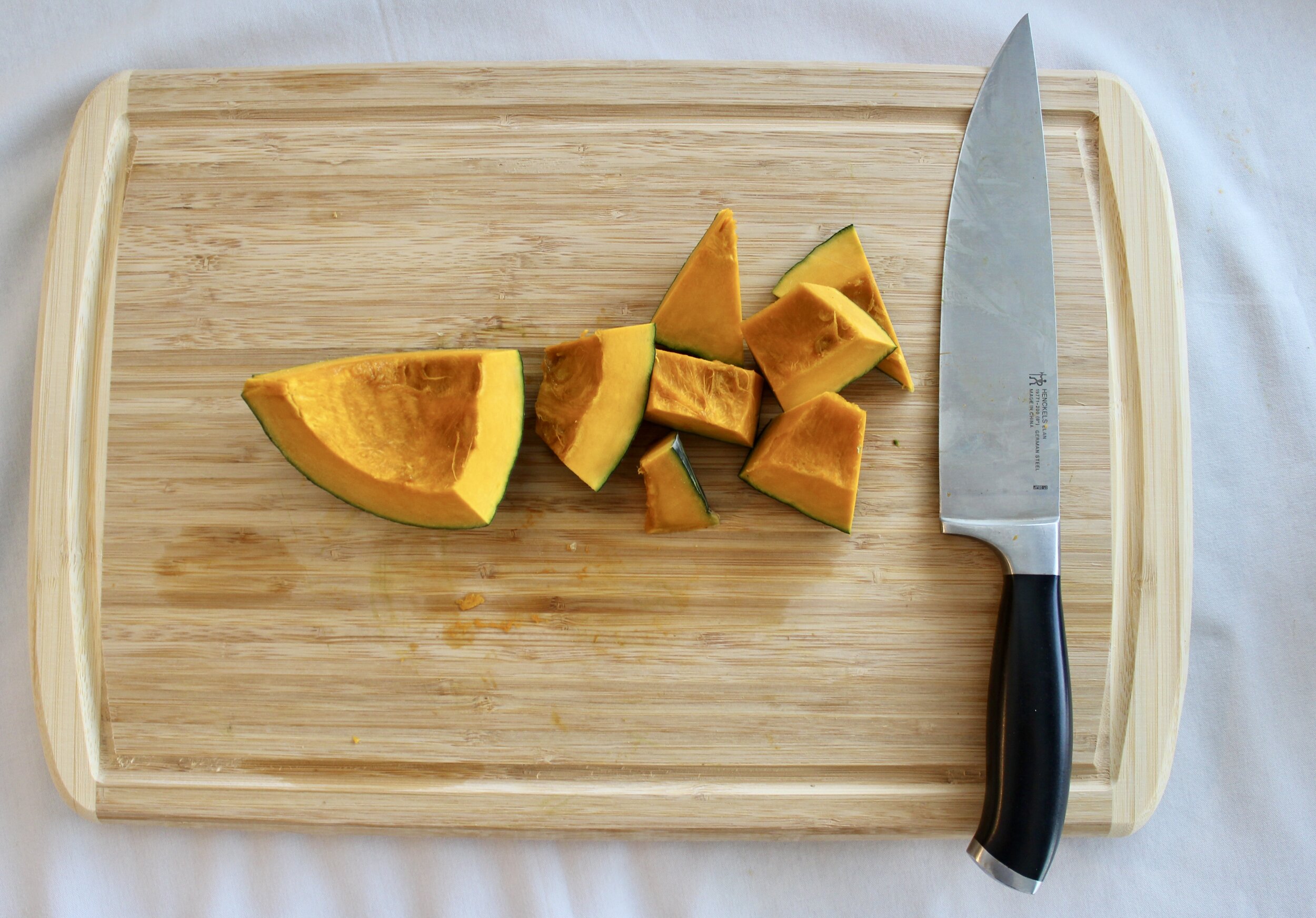A Kabocha How-To Guide
HOW-TO: Shop for Kabocha
Kabocha is fairly common in Asian and general supermarkets. There are also quite a few Farmers’ Markets that sell Kabocha as well, so if you can buy from your local Farmers’ Markets, please do so. All Kabocha pictured in this blog post, if not otherwise noted, are from Yao Cheng Farms, a part of Food Roots’ network of farmers of colors. Shopping at local Farmers’ Markets is a great way to ensure that your produce is fresh and grown with local and sustainable practices. Kabocha is in peak season during late summer, autumn, and early winter (August-December) at Yao Cheng Farms, but you can also find it year-round.
When shopping for Kabocha Squash, look and feel for:
Heaviness (a denser squash feels heavy for its size)
Thick, firm rind
Deep green color (a few golden streaks are good as well)
A few blemishes are okay
Avoid Kabocha with brown spots and cuts
HOW-TO: Store Kabocha
You can store a whole, uncut Kabocha in a cool, dry, dark place for 1 month
Once cut, remove the seeds and store the Kabocha in an airtight container or with a tight wrap in the refrigerator for up to 3 days
HOW-TO: Prep Kabocha
You bought a beautiful and locally-sourced Kabocha. Now what? It’s time to prepare it!
First, wash the Kabocha under running water to rinse off any dirt or dust. If you have bought an organic Kabocha, such as our Food Roots certified squash sourced from Farmer David To, you’re in luck! The pesticide-free rind will be perfectly delicious and ready to eat after a good rinse under the sink.
Next, cut off the stem using a small paring knife or spoon. This will make it easier to cut the Kabocha in half in the following step.
Now, using a large chef knife, cut your Kabocha in half. Be very careful! The rind can be difficult to cut, so take your time and protect your hands. Start with the tip of your knife, then using both hands, cut down in a sawing motion.
Tip: some chefs recommend microwaving your Kabocha for 2-4 minutes or roasting it whole in the oven (400ºF oven for 15-20 minutes), just enough to soften the rind for cutting.
Your two halves should now expose the flesh, pulp, and seeds. Using a large spoon, scrape out the pulp and seeds, leaving a hollow interior. Save the seeds for roasting by washing off the pulp, drying the seeds on a mat, and baking them in the oven with a little oil and spices of your choice. They make a great snack! Or check out our instructions below for how you might be able to save your Kabocha seeds to regrow the plant.
Next, you can cut your Kabocha for your favorite recipes. Check out the following methods for cutting your squash into halves, slices, and cubes.
Halved - good for roasting
Halved: Just leave your Kabocha halves as they are, and with a little brushing of oil and a sprinkle of salt, they will roast beautifully in the oven.
Sliced - good for tempura frying and steaming
Sliced: To slice the Kabocha, place the cut half flat onto the cutting board and slice downwards along the stem-to-tip length of the squash. Thinner slices are good for frying, while thicker slices make heftier snacks when steaming.
Cubed - good for roasting
Cubed: First cut your Kabocha half into four equal wedges (this should give you eight wedges total). Then, you can cube your Kabocha by cutting again crosswise.
The Kabocha rind is completely edible, and we recommend eating the rind to increase nutrition and eliminate food waste. Our Kabocha However, if your recipe calls for removing the rind, you can follow the next steps.
1. First, place your Kabocha half cut side down onto your cutting board. Using a sharp knife, carefully slice off thin layers of the rind, making sure to cut towards the cutting board and away from your body.
2. Once you have roughly sliced away a large portion of the rind, remove the remaining green areas using a vegetable peeler until only the orange flesh remains.
Tip: It is also easy to remove the rind after cooking the Kabocha, since the flesh should be very soft.
HOW-TO: Cook Kabocha
Roasted
Steamed
Fried
Baked
Puréed/Mashed
Sautéed
Curried:
HOW-TO: Regrow Kabocha
There are mixed reviews for regrowing store-bought Kabocha and other squash seeds, but it is an initiative worth trying! Just save the seeds you scooped out while preparing your squash. You can rinse off the flesh and dry them before planting them in quality soil, pointed side down, and watch for a couple of weeks to see your seeds sprout. It is best to start your kabocha squash seeds indoors about 4 weeks before the last frost of the winter/spring season. Or, you can try planting them outdoors at the start of spring.
HOW-TO: Share your love for Kabocha!
You are now well acquainted with Kabocha and the yummy ways to eat it! Take pictures of the masterpieces you make with Kabocha, or if you spot Kabocha when you go eat out! Do you ever see Kabocha in your local Farmer’s Market? We’d love to see how you are using or where you find Kabocha!
In the meantime, download these adorable Food Roots Kabocha wallpapers today. They’ll remind you to munch on Kabocha before the winter season is over!






















